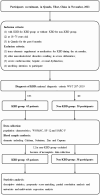Kashin-Beck Disease: A Risk Factor for Sarcopenia and Its Interaction with Selenium
- PMID: 39770964
- PMCID: PMC11678709
- DOI: 10.3390/nu16244343
Kashin-Beck Disease: A Risk Factor for Sarcopenia and Its Interaction with Selenium
Abstract
Objectives: We aimed to explore the possible effects of Kashin-Beck disease (KBD) on the risk of sarcopenia and its possible interaction in the association between the risk of sarcopenia and element concentration.
Methods: This cross-sectional study was conducted among individuals 18-75 years old in Qamdo, a KBD-endemic area. All individuals received physical and radiological examinations before recruitment. Patients with KBD were enrolled in the KBD group based on a diagnosis of national criteria WS/T 207-2010. Healthy individuals without KBD were enrolled in the non-KBD group. Participants with a history of element supplements, other severe musculoskeletal diseases, or organ dysfunctions were excluded. We adopted WOMAC scores for the assessment of musculoskeletal conditions and SARC-F scores for the risk of sarcopenia. Patients with SARC-F ≥ 4 were at risk of sarcopenia. Serum element concentrations were analyzed by inductively coupled plasma mass spectrometry. Dose-relationship effects of clinical scores and element concentrations on the risk of sarcopenia were determined in correlation analysis. Risk factors were identified using univariate and multivariate regression. Statistical analysis was conducted using R software.
Results: A total of 65 patients with KBD and 38 participants without KBD were enrolled in the analysis. After propensity score matching, population characteristics were comparable in the two groups, and the incidence of SARC-F ≥ 4 was determined to be higher in the KBD group (p = 0.002). The WOMAC scores were correlated with SARC-F scores in the KBD group (p < 0.001) and non-KBD (p < 0.001) group, respectively. Further analysis proved that KBD was the independent risk factor for the risk of sarcopenia (p = 0.014). Moreover, high Selenium concentrations were associated with a low risk of sarcopenia in the non-KBD group (p = 0.047), while this association was not observed in the KBD group (p = 0.239).
Conclusions: KBD as an independent risk factor increased the risk of sarcopenia for patients. Although high Se concentration was associated with a low risk of sarcopenia in participants without KBD, this association was not observed in those with KBD.
Keywords: element concentration analysis; endemic musculoskeletal disease; multivariate regression analysis; nutrition-related disease; partial correlation analysis.
Conflict of interest statement
The authors declare no conflicts of interest.
Figures


Similar articles
-
Abnormal Level of Manganese, Iron, Iodine, and Selenium in the Hair of Children Living in Kashin-Beck Disease Endemic Areas.Biol Trace Elem Res. 2022 Oct;200(10):4278-4288. doi: 10.1007/s12011-021-03031-3. Epub 2022 Jan 7. Biol Trace Elem Res. 2022. PMID: 34993910
-
Prevalence of Selenium, T-2 Toxin, and Deoxynivalenol in Kashin-Beck Disease Areas in Qinghai Province, Northwest China.Biol Trace Elem Res. 2016 May;171(1):34-40. doi: 10.1007/s12011-015-0495-0. Epub 2015 Sep 9. Biol Trace Elem Res. 2016. PMID: 26349761
-
Selenium and Iodine Levels in Subjects with Kashin-Beck Disease: a Meta-analysis.Biol Trace Elem Res. 2016 Mar;170(1):43-54. doi: 10.1007/s12011-015-0463-8. Epub 2015 Aug 8. Biol Trace Elem Res. 2016. PMID: 26250430
-
Status and potential diagnostic roles of essential trace elements in Kashin- Beck disease patients.J Trace Elem Med Biol. 2022 Jan;69:126880. doi: 10.1016/j.jtemb.2021.126880. Epub 2021 Oct 25. J Trace Elem Med Biol. 2022. PMID: 34717166 Review.
-
Endemic Kashin-Beck disease: A food-sourced osteoarthropathy.Semin Arthritis Rheum. 2020 Apr;50(2):366-372. doi: 10.1016/j.semarthrit.2019.07.014. Epub 2019 Aug 2. Semin Arthritis Rheum. 2020. PMID: 31548049 Review.
References
MeSH terms
Substances
Grants and funding
LinkOut - more resources
Full Text Sources

